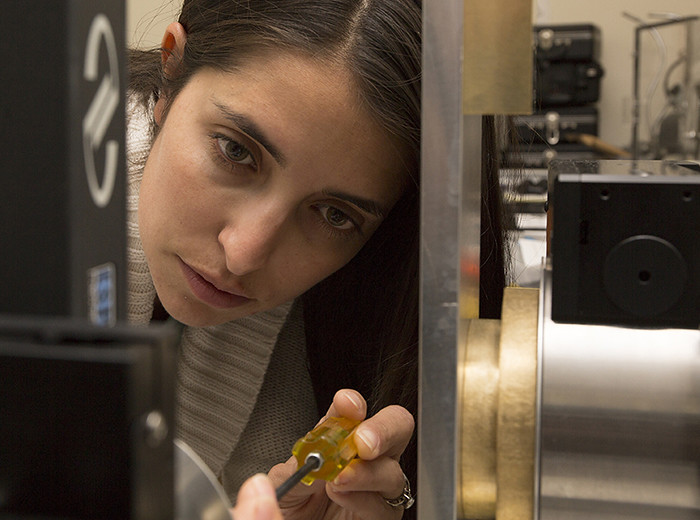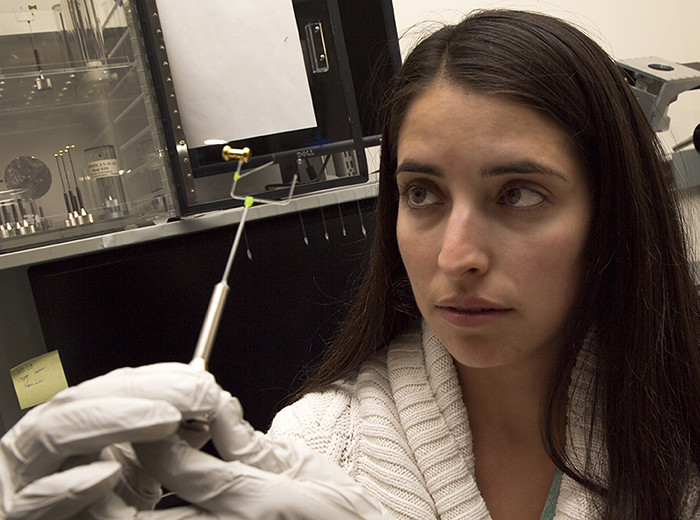Engineering solutions to national security challenges

Tana Cardenas at work on a target for an opacity shot in September at the National Ignition Facility.
As a child in Galisteo, Tana Cardenas liked to walk around the house with a screwdriver, tightening every loose screw she saw. And, when she was eight years old, she remembers: “Someone asked me what I wanted to be, and I said, "I’m going to be a mechanical engineer.”
Cardenas was true to her word. She is now an R&D engineer and designs the targets that Los Alamos physicists put in the path of lasers at the National Ignition Facility (NIF) at Lawrence Livermore National Laboratory and the Omega laser facility at the University of Rochester.
The experimental campaigns at NIF and Omega serve Stockpile Stewardship and the efforts to achieve ignition: energy-producing inertial confinement fusion.
Derek Schmidt, a senior target engineer Cardenas considered her mentor, says he sees her as a bright, hard-working engineer possessed of natural leadership ability. “She is leading some of our most visible and critical campaigns for LANL,” he says, “and doing a spectacular job balancing customer service and professionalism within our stressful working environment.”

Tana Cardenas.
Cardenas’s projects include the Marble and Double Shell projects, which focus on how the material mix in a target’s physics package reacts to shock and intense radiation. Her work begins when physicists bring her their target specifications. She translates their ideas into reality and produces an initial design that is then altered and refined in collaboration with the clients.
“We meet frequently to make sure I’m accurately interpreting what they need,” she says, “but it’s always a balance between what they want and what is physically possible. I help them meet the balance.”
Cardenas uses computer-aided design software to draw, at the size of a monitor screen, targets that will be small enough to perch on a fingertip. The same software lets her digitally assemble the target and place it in a virtual mockup of the NIF or Omega target chambers. Both NIF and Omega may host a project’s completed targets because NIF experiments are often preceded by shots on Omega.
“You get only two or three shots at a time on NIF,” Cardenas explains, “and it’s very expensive. By trying some things out on Omega, the researchers get more data at less cost and learn new pieces to validate their codes. Then at NIF, their shots are more robust because they’ve practiced on Omega.”
For finished target designs, external companies fabricate some of the components, such as the capsules and simple components. Fellow team members at the Target Fabrication Facility machine many of the other, more developmental components. Cardenas helps orchestrate the manufacturing time for all the processes and works closely with machinists and scientists to solve any problems.
The facility also houses target assembly, an exacting procedure requiring magnified optics and custom robotic stages as well as the use of toothpicks and thin glue sticks for positioning and adhering all the parts.
Projects also need what Cardenas called “rudimentary objects.” These trussed structures are designed for holding and positioning target components in the assembly. She designs and models these for additive manufacturing. Her workspace has additive machines, but if an object will be used at NIF, an outside company produces it, using a proprietary NIF-approved substance called MicroFine Green.
Cardenas has noticed that those objects tend to come back slightly oversized, so she accounts for the sizing anomaly in her designs.
A challenge facing Cardenas and her fellow team members is related to the Double Shell project, which is named for the double-shelled target it requires. Designing that target to be successfully machined is difficult because the target will include a tube that could easily be broken. The design and assembly methods have to accommodate that tube.
“I have no idea how we’ll do that,” Cardenas says, and then smiles. “But we will.”
Read a longer version of this profile here.

Tana Cardenas.






